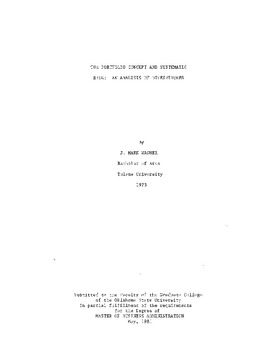| dc.contributor.advisor | Jackson, James F. | |
| dc.contributor.author | Wagner, J. Mark | |
| dc.date.accessioned | 2016-05-20T20:35:59Z | |
| dc.date.available | 2016-05-20T20:35:59Z | |
| dc.date.issued | 1981-05 | |
| dc.identifier.uri | https://hdl.handle.net/11244/34788 | |
| dc.description.abstract | Scope of Study: This study is concerned with the divestiture of divisions or subsidiaries of corporations. The various types of divestitures are identified with the possible reasons for their use. The three merger waves witnessed by the U.S. economy are reviewed with their relationship to the use of divestitures by conglomerates. Additionally the recent increase in the frequency of divestitures is discussed along with the change in the economic environment attributed as the cause of this increase. The purpose of this report is to examine one of corporate management's intentions for a divestment; namely, the improvement of financial performance. This improvement can result from the reduction of investor risk. The beta coefficient, as a measure of systematic risk, was obtained for the divesting company, the acquiring company, and the divested unit for a sample of 30 divestitures. A paired-comparison analysis was done to test the hypothesis that risk reduction serves as a motive for divestiture. Specifically the hypothesis could be accepted if the beta of divesting firms were observed as significantly greater than divested units. Also, if the divested units' betas were greater than the acquiring firms', then the second hypothesis that the motive for the purchase of the unit is other than risk reduction could be accepted. | |
| dc.description.abstract | Findings of Study: It was found in this sample of divestitures that the betas of the divesting firms were not significantly different from the divested unit betas, while the divested unit betas were found to be significantly greater than the acquiring firm betas at the .0058 level of significance. Also, the betas of divesting firms were significantly greater than the betas of acquiring firms. Therefore, it is concluded that systematic risk does not play a major role as a motive for divestiture in the case of the divesting corporations. The acquiring corporations, in purchasing divested units with greater risk, is construed as being motivated by the expectation of increased earnings. | |
| dc.format | application/pdf | |
| dc.language | en_US | |
| dc.rights | Copyright is held by the author who has granted the Oklahoma State University Library the non-exclusive right to share this material in its institutional repository. Contact Digital Library Services at lib-dls@okstate.edu or 405-744-9161 for the permission policy on the use, reproduction or distribution of this material. | |
| dc.title | Portfolio concept and systematic risk: An analysis of divestitures | |
| osu.filename | Thesis-1981R-W133p.pdf | |
| osu.accesstype | Open Access | |
| dc.type.genre | Master's Report | |
| dc.type.material | Text | |
| thesis.degree.discipline | Finance and Management | |
| thesis.degree.grantor | Oklahoma State University | |
